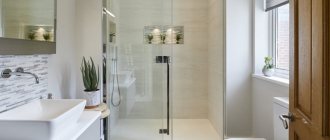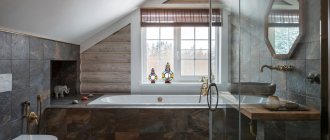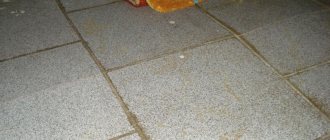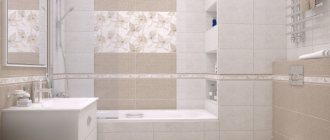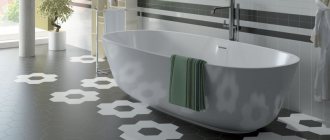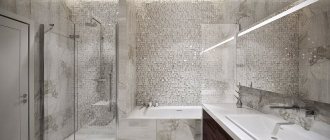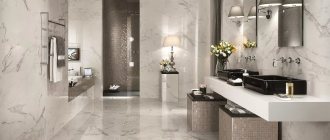Click to share
more
There's a reason tile is often a bathroom material of choice: it reflects light, it's durable, it's easy to clean, and it freshens up the space. We've put together a list of bathroom tile design ideas to inspire you and tips for choosing one. How to choose tiles for the size and shape of the bathroom? How to position tiles correctly to visually enlarge a room? Will patterned tiles look good in every bathroom? How to get maximum effect with minimal resources? You will find answers to all these questions in the article.
Tiles are a good way to update your bathroom without a major renovation. Keep in mind that the grout between tiles can become dirty if not cleaned properly, and regular cleaning is important to maintain aesthetics.
Tile is more expensive than paint, so the amount of material and complexity of your design will likely depend on your budget. Options range from minimal use on a curb, for example, to maximum use in a floor-to-ceiling design. And each implementation, of course, can be made in different materials, be it classic tiles or multi-colored mosaics.
Types of bathroom tiles
The variety and huge selection of tiles on the market means you can get overwhelmed when planning your bathroom renovation or decoration. However, there is also a good side - a variety of materials, patterns and shapes of tiles allow you to create an original design that will suit almost any interior.
When considering the choice of tiles, it is worth considering several parameters:
Tile size is critical to the final finish. From small cubes ideal for finishing an oval bathtub, standard square and rectangular tiles ranging in size from 10 cm to 40-50 cm, to large formats exceeding 1 m. Small tiles mean a lot of joints, they are very sensitive to dirt and require a lot of time to cleaning
Tile material
The most popular currently are ceramic tiles, which, depending on the materials used and the firing method, are divided into:
- porcelain stoneware - fired at high temperature, durable, for use on walls and floors,
- glazed tiles are relatively thin tiles, they can be used as wall decoration,
- terracotta is a tile made from purified clay, for use primarily on floors.
Tile flooring is common in bathrooms and offers a good alternative to hardwood, which can warp if exposed to too much water. If you decide to put ceramic tiles on the floor, look for a grade 1 or 2, a water absorption rate of less than 7 percent and a coefficient of friction above 60, which are slip-resistant and can withstand water.
Also pay attention to porosity; you will need more impermeable floor tiles due to water exposure. Vinyl will perform better than ceramic tile and is one of the most popular flooring options because it is inexpensive and practical (safe, easy to install and maintain).
If your budget allows, all bathroom tiles can be a fun way to combine durability and style. Vary the color, shape, pattern, size and texture of tiles by using different materials on your floors, walls and shower stalls.
Among the materials most often used for bathroom tiles, porcelain tiles are very common. Extremely durable than many other tiles (eg tiles), it allows for many decorative possibilities: colorful, glazed, with or without reliefs, imitation wood, concrete or natural stone. Additionally, porcelain tiles are very easy to maintain and are available in many formats.
Another solution that is ideal for lovers of modern bathroom design is mosaic tiles, which are glass tiles for laying with a nylon mesh. It offers an endless array of colors and graphics to complement porcelain or tile style walls. Whether in small touches or in larger bathroom spaces, mosaics enhance style and add a truly original touch.
If you have a separate shower stall, you may want to consider using different tiles for your shower space. You will have to make sure that you buy anti-slip tiles. It also makes sense to use the same tiles for your shower floors and walls to create a seamless look. Make sure that any tile you choose for your shower complements the rest of your bathroom.
Traditionally, the most common solution in bathrooms is terracotta and clay faience. Easy to maintain and style, it also offers a wide range of styles and colors. It should be noted, however, that while faience remains the cheapest bathroom finishing offer, the latter remains more delicate than porcelain tiles (risk of chipping).
Modern design options with tiles in the bathroom
Countless numbers of them can be found on the Internet, sometimes your eyes run wide from the variety of solutions even for small rooms, but it’s difficult to choose one that suits your financial capabilities and the wishes of all household members.
Ceramic tiles imitating marble
Without a doubt, the interior of a bathroom with such tiles will acquire elegance, because marble has been revered by different peoples since ancient times, it was used only to decorate palaces. It looks great on the floor and walls, its pattern with numerous black streaks has a calming and at the same time mesmerizing effect.
You might also be interested in watching - Characteristics and design of marble tiles for the bathroom
It will never lose its relevance and will not get boring, unlike its monochromatic counterpart. Artificial marble tiles have many designs, colors and shapes, so you can decorate any surface with it or combine any decor with another suitable material, just by choosing the right tone.
Ceramic tiles imitating stone
This is a rich finishing material that fascinates with its natural forms, because artificial stone is difficult to visually distinguish from natural stone. It withstands mechanical stress, comes in a variety of shapes and shades, and is used to create a durable and strong finishing layer.
Stone-like tiles are used not only for bathrooms, but also for living rooms, hallways, kitchens; when choosing it, its natural shades and specific texture play an important role.
They often line corners and irregularities, after which they look harmonious with smooth walls.
This material is used to decorate Khrushchev buildings, the dimensions of which are small; it will contribute to their expansion. The heterogeneity of the material can be skillfully played up and placed in frequently used places.
Ceramic mosaic
Its scope of application is limitless, it is perfectly used for hard-to-reach places, on radiuses and roundings, it is often used when decorating the bottom of showers and Jacuzzis.
With its help, artificial waterfalls are created that fall directly onto the floor. Looks great in combination with regular tiles, has a rich range of shades, and is easy to install.
Don’t forget to also look - Mosaic tiles for the bathroom: features of choice
How to choose tiles for the bathroom - choosing a finish
Bright glazed tiles reflect light and create a clean, spacious feel. Dark and patterned ones are a great complement to light ones. Placing dark bathroom tiles can make a room appear smaller, but this is not always the case. Bathroom tiles in bright colors are a good complement to the primary colors used. Floral and geometric motifs are most often used for wall decoration.
The pattern on the tiles is important for the optical design of the space. This gives it a certain character and fits into a certain style (for example, a gray loft-style bathroom). However, the use of patterned tiles must be approached skillfully. Depending on the layout, tiles with the same pattern or a series of tiles that create larger graphics work well.
Square, rectangular, hexagonal, octagonal - these are the main shapes of bathroom tiles. A skillful combination of several shapes and a play of colors allows you to create a unique interior design.
Combination of different colors
It is important to ensure that the combination of different colors of tiles in the bathroom decoration is harmonious.
| The main idea is not to overload the bathroom with an abundance of colors and mix 2-3 shades together. If you decide to choose bright tiles with an original pattern, try to use them in moderation. The remaining space can be filled with neutral colors - beige, gray or another suitable tone. At the same time, you can combine these slabs with various types of textures depending on the chosen interior style. |
Classic colors for the bathroom are blue and light blue with marine-themed designs. Green and turquoise shades also do not go out of trend. They are combined with beige and sand shades.
Which tiles are suitable for a small bathroom?
Many people wonder how to place tiles in a small bathroom to make it appear larger. There are also ways to create an impression of space and coziness in a small room. It is worth remembering a few simple rules:
- When considering the best color for a small bathroom, it is best to choose bright and cool colors. To make the interior warmer, you should use contrasting accessories.
- Small bathroom tiles should not have a pattern. Especially large patterns and decorations can spoil the interior. It is better to use solid colors and play with the texture of the tiles.
- Placing reflective tiles on the walls and cleverly designed bathroom lighting will make a small space appear larger.
- When choosing tiles for a small bathroom , you should consider those that will have an easy to clean surface that does not leave streaks. Glazed tiles with a smooth surface are definitely the best choice.
- Contrary to appearances, large bathroom tiles for a small space are the best choice. Just remember to adhere to the principle of “one color on the wall, another on the floor.” This gives the effect of a homogeneous surface, which - when using glossy tiles - additionally illuminates and gives a sense of depth.
The best colors for the bathroom
Trendy bathroom tiles rely on vibrant combinations of white and gray, often inspired by colors and patterns taken directly from nature.
Wood-effect tiles or large-format porcelain tiles that accurately imitate the pattern of noble marble have been popular for many years. Soft colors of bathroom tiles combined with nature-inspired patterns are a way to create a timeless composition.
This is especially noticeable in the photo of fashionable tiles in the bathroom.
Dark or light bathroom tiles?
When choosing tiles for the bathroom, you should first focus on the colors. Dark or light? What to choose for the floor and what tile to choose for the wall in the bathroom? Solid colors, embellishments, or maybe bathroom tiles arranged in a larger layout?
Light walls give the impression of space and reflect light, so they are well suited for small interiors and sloped loft bathrooms. Bright bathroom tiles pair well with white fixtures and fittings such as vanities, bathtubs or wall-hung toilets. In turn, dark bathroom tiles are most often used to decorate large rooms in the Art Nouveau or New York style.
One or more dark walls provide a good visual contrast for bright, large spaces, as well as a good backdrop for patterns. Dark walls allow you to display original accessories and unique design of plumbing fixtures. However, when choosing a dark design, you should especially take care of good lighting in the bathroom.
Tile selection
Any type of tile is suitable for a medium to large sized bathroom. For a small room, tiles that are too small are not suitable - they make the room smaller, so it is better to use large and medium-sized options.
It is better to combine mosaics in the bathroom with larger tiles. This allows you to zone the space, visually expand it, create smooth transitions and bright accents.
Dark tiles in a room of modest size narrow the walls, and the abundance of bright colors makes the room too aggressive and oppressive. In this case, it is better to choose pastel, neutral and light colors. And all this is diluted with stylish elements, bright accessories, interesting materials.
Which tiles are suitable for the bathroom floor?
When arranging a bathroom, you should focus not only on the choice of wall tiles, but also take into account the color combination with floor tiles. A contrasting color combination of walls and floors can completely change the character of the interior.
Bright, classic floors give a clean, fresh impression and are a good complement to light wall tiles, especially in small bathrooms. However, to prevent the white bathroom from being too cool and sterile, you can choose Scandinavian-style accessories. Bathroom furniture made of wood, accessories in warm colors, plants, natural materials - all this makes the bathroom cozy.
Is dark flooring suitable for a bathroom ? It is certainly effective and fits perfectly into the modern interior style. If positioned well, it will look good in both large and small bathrooms. It is also a good backdrop for showcasing a unique bathtub or shower design.
Dark wall and floor styles complemented by shiny gold or silver fittings create a glamorous design that adds status to the bathroom. However, from a practical point of view, it requires more frequent cleaning than white flooring.
Design solutions
Laparet chief designer Anastasia Efremova recommends the following design ideas:
- You can choose tiles for the bathroom with a combination of eco-friendly colors of living nature - wood and patterns with foliage of green plants.
Photo of tiles with eco-decophone Focus
- If you want an unusual finish in the bathroom, you can focus on porcelain tiles with the textures of natural stones: marble, onyx, granite. Such coatings look fundamental and harmonious. They are made in dark and light colors of natural stone and also correspond to the trend for environmental friendliness.
Photo of tiles with Onyx Smoke natural stone textures - A good way is to add wood-grain tiles in brown shades to the stone. An accent wall can be lined with any of these types of finishes.
Photo of tiles with wood texture Calacatta Royal - Using a modern designer surface with a unique color scheme is also always a good option. The Krazzy Blue collection falls into this category. It forms a natural combination with marble slabs. In such porcelain stoneware textures with accent decor, blue colors go with all cool shades, and brown colors pair with warm textures.
Photo of Krazzy Blue tiles
Bold bathroom tile patterns
bathroom tiles we have , it’s worth thinking about how to give it a unique style. The size of the interior does not matter, the main thing is the idea. It is the finishing of the bathroom with decorative tiles or fittings with a unique design that determines the final effect.
Patterned floors and original patterns on the walls give the interior a special character. Geometric motifs arranged in a certain rhythm add depth, and floral decorations on the tiles create a pleasant and romantic atmosphere in the interior. An alternative is photo wallpaper and glass prints that cover the entire wall.
In minimalist and monochrome interiors, spot elements of bright colors are ideally complemented: contrasting letters, decors, LED lighting, accessories. Moreover, the original color of the tiles on one wall or a fragment of the floor can not only become the most important decoration of the bathroom, but also optically correct its proportions. Mosaics, tiles with oriental and Moroccan patterns create refreshing accents against a neutral background. However, you should use them in moderation because colors that are too saturated can be overwhelming.
When deciding on decorative finishing of walls and floors, you need to show moderation and consistency in the choice of equipment and accessories. Against the background of decorative tiles, a white washbasin with simple, classic shapes will look better than a washbasin with an original design. Its minimalistic design will not compete for attention with a bold pattern on the wall.
Playing with color is one thing. An original finishing effect can be achieved using structural tiles. Several large format tiles with attractive surfaces and clever lighting create a stunning visual effect.
Bathroom - large or small
The size of the bathroom affects the choice of color for the facing surface.
Small
If you are renovating a small bathroom, choosing the right color can make it look larger and more spacious. To do this, you should choose cool shades of light colors. Warm shades make a room smaller. Monochrome black and other dark colors will also steal the show. It is better to use white color carefully, adding shades of turquoise and gray to it. A good design tip is to tile a small bathroom with beige tiles with a glossy reflective surface. You can also use mirror mosaic inclusions, hang a large mirror and add light.
Studio
Big
For large bathrooms and toilets, you should adhere to the following rules: • You can freely use large-format tiles • It is important to consider the color of the plumbing fixtures so that they harmonize with the color of the floor and walls • In a large room, it is better not to use more than 2-3 colors at the same time
Also, black color in a spacious bathroom will look representative and expensive. But the black finish requires more light. Against this background, you can use metal borders with a golden tint, gray, beige colors, warm versions of bright colors for the wall.
Granada
White color can be combined with any other color in a large bathroom. A bright, rich palette can be used as accents.
How to lay tiles?
Before you start renovating, it is worth studying the market and finding out where to buy bathroom tiles , how much it costs to lay the tiles and how to install them.
What's worth knowing?
- What does foundation preparation look like? The surface under the tiles must be thoroughly cleaned not only from dust and dirt, but also from any stains. After rinsing with clean water and drying, leveling solution can be applied if the substrate requires it.
- Rule of thumb : Large floor tiles. Not only is the Eapmi5 easier to position, but it's definitely better for everyday use. Smaller joint surfaces reduce dirt accumulation. For the floor, it is better to choose tiles with increased resistance to mechanical damage, for example, porcelain stoneware.
- Which tile is suitable for the wall? There is no golden rule here; tiles can be any size. Wall tiles are primarily decorative, so their size, shape, material, colors and textures are used to convey the interior design idea.
- How to decorate the bath, shower and toilet area? Places in the bathroom where there is a possibility of moisture penetration should be protected with special tapes and insulating collars or liquid film. Only on such a prepared base are tiles laid. The areas around the bathtub, washbasin, shower tray and toilet deserve special attention. Designers often use decors, planks, baseboards, patterned tiles or mosaics made from small tile fragments.
- To what height should I lay tiles in the bathroom? Remember that tiles in the bathroom do not necessarily have to occupy the entire surface of the walls, but only in places that are especially susceptible to getting wet. For this reason, tiles are usually laid on the floor and up to a certain height on the wall - ideally 2/3 of the wall, counting from the bottom. This is the height level that allows you to protect the walls from splashes of water from the washbasin or toilet. You should also use tiles to protect the entire wall behind the shower stall, up to the top edge or to the ceiling.
Distinctive properties of tiles
Tile, unlike other materials, has many practical characteristics:
- demonstrates resistance to aggressive external environments and water, it does not deform when exposed to them and does not change its properties;
- non-toxic and does not cause allergies, which allows it to be used in any room, including the bathroom;
- fireproof, does not burn and does not support combustion;
- biologically inert, fungi and bacteria do not settle or reproduce on its surface after special treatment;
- does not require special care and is resistant to cleaning agents;
- has low moisture absorption, which means that it can be used in specific areas.
Each type of tile has its own characteristics.
Ceramic
It is similar in durability and practicality to paint. Only when choosing it, despite the variety of shades and textures, should you adhere to the rule: fewer flashy details and bright colors.
The fact is that the bathroom is a small room and if you decorate it in an extraordinary way, the space will narrow significantly, and a person’s skin, reflected in the mirror, will take on the shade of the walls.
Ceramic tiles and their installation will be more expensive than other finishing materials, such as lining, plastic panels, vinyl boards, but they are much stronger than each of them and fully pay for their costs.
In addition, you can use any cleaning agent to care for it without the fear that it will leave stains or get defects.
The tile is safe because it is made of clay and water; it may contain impurities, but they burn out after annealing.
This is a completely natural material, and it is also non-flammable.
Porcelain stoneware
Almost all types of ceramic tiles are durable, but porcelain tiles have the highest rating among them. It is produced by pressing without glazing.
They can be used to cover not only walls, but also floors. Both white and colored colors can be used as a base.
The main feature of this type of tile is the inclusion of granite in its composition, which not only gives it visual effects, but also helps to increase stability and strength, due to which it copes well even with increased loads, which is why it is often used for laying on the floor.
Stone
Decorating rooms with stone is now increasingly gaining momentum; in many interiors you can see the remains of brick in its original form; natural stone material is very heavy, so tiles that imitate it are in special demand.
Artificial stone, like natural stone, has high moisture resistance among other types of finishing dies, it is environmentally friendly, and only natural materials that do not emit harmful substances are used in its production.
Stone tiles are durable, resistant to mechanical damage, look beautiful and come in a wide range of colors.
Easy to care for and looks unobtrusive in the interior.
Glass
It is practical and has an aesthetic appearance; those who doubt its safety should know that if a glass slab accidentally breaks, it does not shatter into fragments like glass, but crumbles into small pieces with blunt edges and cannot in any way injure.
During manufacturing, the glass material undergoes special hardening, which eliminates any deformation and gives it strength and resistance to external influences. Its original appearance is preserved for a long time.
What are rectified tiles?
Rectified bathroom tiles maintain the dimensions adopted by the manufacturer with an accuracy of 0.2 mm, and the angles between adjacent sides are exactly 90°. The edges of ordinary (so-called calibrated) tiles are rounded, while the edges of rectified tiles are sharp. This gives the tile a more modern character - the surfaces of such bathroom tiles are more uniform, and the edges of the elements are less noticeable.
Rectified tiles as a post-processing product are usually more expensive than calibrated tiles. Stylistic considerations when decorating a bathroom may prompt you to choose rectified tiles. In a minimalist bathroom, it is difficult to imagine unrectified bathroom tiles with a visible wide joint.
Choosing rectified bathroom tiles also allows you to safely use a combination of elements of different sizes, that is, a combination of several formats in one room. These tiles are also well suited for cutting mosaics, which are made by cutting a large tile into smaller pieces, have sharp edges and therefore look best when paired with tiles with equally regular edges.
Rules for using tiles
The order of placing finishing material on vertical and horizontal surfaces may be different depending on the result that the owner of the room wants to achieve. Designers highlight several options:
- classic layout - the tiles are laid exactly horizontally at the joint;
- with offset - the tiles are arranged in even and odd order, which are shifted relative to each other, this layout material allows you to simulate masonry;
- Rhombic - square tiles rotated 90°, joints diagonal;
- at an angle - the angle of inclination of the finishing material changes depending on the wishes of the customer.
Popular questions
Are wood-look tiles for the bathroom a good choice?
exotic wood panels on the market that are ideal for high-moisture areas such as the kitchen or bathroom, ceramic tiles are still more convenient for everyday maintenance in such areas, especially the bathroom. Wood-effect porcelain tiles are an excellent solution for an original modern bathroom.
When the walls and floor look like they are covered with wood, we feel like we are in a traditional Scandinavian sauna. Wood-look tiles are much more durable and easier to maintain than even the best wood panels, but they are just as visually appealing. If you're dreaming of a stylish bathroom, wood-look tiles seem like the perfect solution.
Should there be the same tiles on the wall and floor?
Of course, the tiles on the wall and the floor do not have to be the same .
While it's best not to combine tiles from different manufacturers as they come in different thicknesses and sizes, combining patterns, colors and shapes into a collection of tiles from the same manufacturer is just a matter of skill and artistic sensibility.
To what height should bathroom tiles be installed on a wall?
As we've pointed out several times before, laying tiles from ceiling to floor is not the best solution for small bathrooms . Here, tiling and painting the walls in a ratio of 1/2 to 1/2 or 3/4 to 1/4 works well. However, if you still want to lay tiles from ceiling to floor, use different shades and decorative strips (decors) to break up the monotony of the interior.
Which bathroom tiles are trendy?
Is there a fashion for bathroom tiles?
Certainly.
As usual, trends are set by tile and... interior designers. Fortunately, as in other areas of fashion, you can risk saying that everything is fashionable - you just need to skillfully combine patterns, colors and shapes. Of course, bright colors and textures that imitate nature: stone, wood.
In small and large bathrooms, gray, pastel colors and noble minimalism reign - it should be gentle and without unnecessary decorations.
Bathroom furniture in a modern style
The companies that produce it focus on the correct form and versatility of each individual element.
Furniture made of wood and MDF is the cheapest, but over time it can accumulate moisture and dry out.
If you choose a tabletop from wooden and stone options, then you should choose the latter, they are more durable.
In the corners of the room you can place plastic cabinets in which it will be convenient to store all soap products, as well as clean towels. It is better to hide washing machines and dryers under the countertop, so you can rationally use the space above them.
Care instructions
Almost all types of tiles are resistant to detergents. But before purchasing, you need to clarify this information. Caring for ceramic tiles is very simple. In order for it to shine and please the eye, you need to wipe it with a solution of ammonia (3 tablespoons of ammonia per 1 liter of warm water). It is better to do it with a brush with soft bristles or a cloth.
It is necessary to ensure the cleanliness of the tile joints. Once every 3-4 months they must be treated with a special antifungal agent.
Tiles with ornaments or patterns
For those who want to move away from the principles of minimalism and add variety and more details to their life, it is worth paying special attention to tiles with all kinds of patterns.
You can choose patterns with animals, plants, and so on.
- One of the most striking examples of such patterned tiles is floral. It will fit well into a Provence style bathroom.
- The only condition that must be met when choosing: do not overdo it with the palette.
- It should be remembered that small flowers look neat and do not overload the eye, large ones visually make the room smaller.
- Another successful, stylish and modern option is to opt for photo tiles.
- With its help, changing the interior space of a room will not be difficult.
You can buy a tile with a ready-made “story”, be it a landscape, portrait or abstraction, or order any original image, guided by your own sense of beauty.


